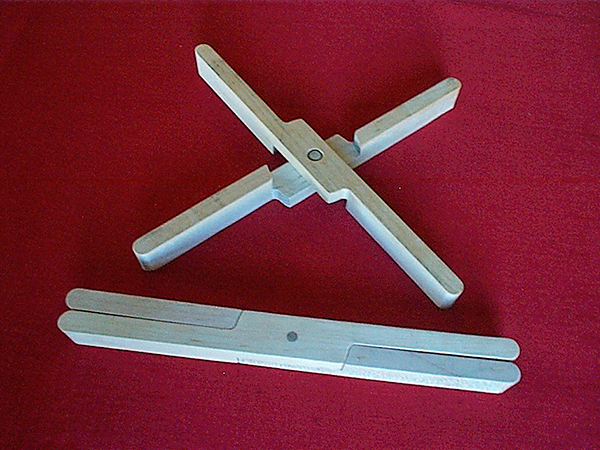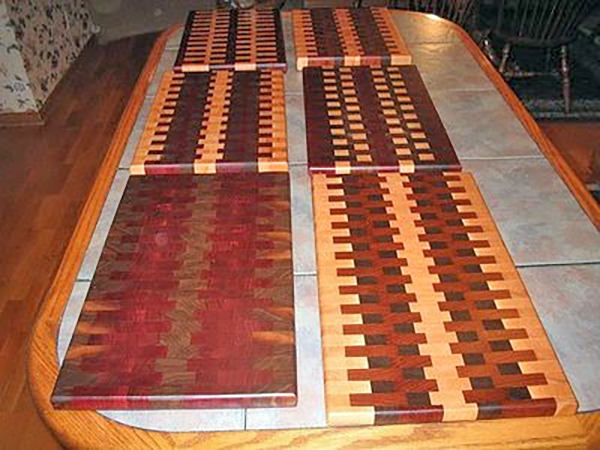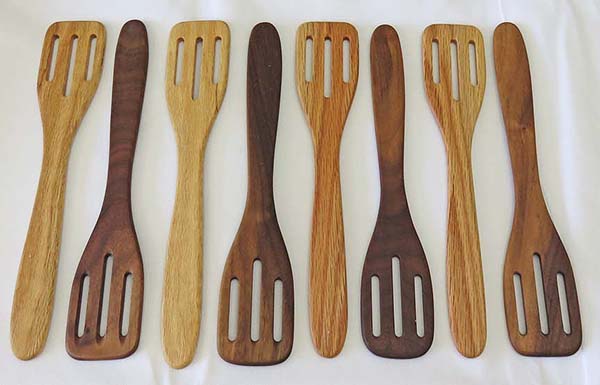
Last week, Rob asked you to share kitchen utensils you’ve produced. Here are some you’ve made or still plan to make, plus a few that family members have made that continue to go the distance in your kitchens. – Editor

“Here are two carved spoons I made from poplar. This was my first attempt at using tools not really suited for the task, but they turned out successfully anyway.” – Tom Moss
“I use snow shovel handles to make spurtles (wooden sticks for stirring porridge), as they are made of several wood species. Each handle gives me four blanks. Everyone I have given them to still use them. I even took a few to Scotland for relatives and friends. The nice thing is, they turn quickly and only need sanding.” – Andy Stanton
“My wife recently asked me to renew the oil finish on the wood napkin holder that our son made in seventh grade; he turned 49 on Jun 30! We have several other napkin holders, but that one always sits on our main dining table. He has a BS in computer science and is a team leader at a software firm in Silicon Valley, but that napkin holder in the shape of a swan symbolizes his first accomplishment. I made a galvanized metal sugar scoop with soldered seams in general shop as a high school freshman, and my mother used it until she moved to an assisted living facility; I was about 64 years old at that time. The leading edge was worn sharp; my wife commented one time that I should break that edge while my wife was helping Mom in the kitchen. I went on to become a mechanical engineer, Army officer, vice president in a large hospital, father of four college graduates, etc., but she never traded that scoop that I had hand-made for a new one. My dad confided one time that he tried to get her to toss it out after the galvanizing had worn off, but she refused.” – Robert W. Ball

“I first saw these ‘kitchen squirrels’ at the Kentucky Artisans Center, Berea, Kentucky. I probably made over 100 and counting. Hold your squirrel by his tail and use the back of his neck to pull out a hot oven rack. The neck area below his chin pushes the rack back.” – Captain Frank
“On my own ‘Round Tuit’ list of brief projects: a pair of wide spatulas with curved ends, suitable for tossing ingredients in a wok or a salad bowl. Possibly with cut-pits as handles, which I think might make these tasks more ergonomic.” – Joseph Kesselman

“I like giving and selling nice laminated cutting boards. The problem is that people don’t want to ruin them by using the boards. So I also make these folding trivets, and people are not afraid to use them. Here are some of the instructions I provide with them. ‘This is a folding trivet. It will protect your table from heat sources like hot dishes and pans. Don’t forget to open up the trivet before using. It kind of forms an X when opened. If you try to use this trivet without opening it, it’s very difficult to balance something hot on it…After use, you can fold it for easy storage. When folded, this trivet can fit almost anywhere. Note #1: This trivet is designed to protect your table from heat sources up to 350° Fahrenheit … probably. Caution: Your results may vary. So, don’t complain to me if something goes wrong. It’s important that you use your own judgment when using this device. Note #2: This trivet was made from reclaimed hardwoods responsibly harvested in Wisconsin, or somewhere… (It is reclaimed after all.) Also note: No fingers were injured during the making of this trivet.'” – Bob Hartig
“I make roux spoons.” – James Brunk

“Several years ago, I made cutting boards for several ladies in my life, daughters and friends. They all still hold prominent places in their kitchens. I see them on kitchen counters all the time. What I like best is I see them used. It’s funny: I always thought of cutting boards as eighth-grade shop projects, but they sure can have an impact for people.” – Ron Grover
“I have a DOOZIE! More years ago than I can remember, I made cutting/serving boards in a ‘rainbow’ pattern. The design resulted in three identical SHAPED boards, but all different in makeup. Three blanks, one each of walnut, cherry and maple, are double-sided-taped together and cut in arcs on the bandsaw, then reassembled, mixing the species. One such board, primarily maple with cherry and walnut inserts, went to my youngest brother as a Christmas gift, I believe in ’92 or ’93. My sister-in-law cuts on only one side and stands the board on-end against the backsplash to dry. On a recent trip back to Minneapolis, to attend the wedding of one of my nephews, I was served cheese and crackers on the same board! It is easily over 25 years old!” – Bruce Edsten
“A simple napkin holder I made at school in sixth grade, around 1967 (might have been fifth grade, definitely wasn’t later than sixth). It’s a basic “U” shape; bottom, tall back and short front. Made out of 1/4″ walnut with butt joints, glue and nails. We had Dremel Moto-Shop Jig Saws at school (I still have a hard time calling this type of saw “scroll”). I collected maple and oak leaves and cut their shapes out of 1/8″ contrasting wood (no idea what kind) and glued them on the front. I don’t remember finishing it. I wish I knew what we used. Maybe Deft? That’s what we used in seventh-grade woodshop, but that was a different school/district/town. When my son was in middle school years later, around 2005, I got to tour the basement of his school. There sat a workshop that was closed up years earlier. Only the building maintenance staff went down there. Students hadn’t used it in years. Sad. When my son was about the same age, he and his friends in his Cub Scout den made similar napkin holders. I have one of those old Dremels, and a couple of other families brought in scroll saws. My son put a snowman on the front of his (mom is big on Christmas decorations).” – Edward Colaianni
“It isn’t necessarily a kitchen item, but I made plant stands out of birch plywood about 12” square and 23-3/4″ tall with all the edges mitered, including the top. That became the most requested item I ever made for multiple members of my family and was a surprise to me. That was awhile back, and I have yet to repeat it. Maybe this year…” – Frank Clements
“Yes, these little (spatula) gadgets are easy to make. I’ve made them for the whole family. I use ash because that is what I have a huge source of. The best part is that when (not if) they are put in the dishwasher, the usually come out looking fine — at least for the first three years … Thank you for the incentive to make some more.” – Barney Heller

“I read your editorial last week and wanted to share what I made back in 2016, which is similar to your spatulas project. Like you, I gave these away as presents. Since then, I’ve acquired some woodworking equipment instead of using my milling machine, like I’ve done so many times in the past (I’m a machinist by trade). Anyways, here is what I made, which is what we use to prepare ground meat with. This kind of tool works well, because the ends are rounded and are thick enough to mash with. I used oak and black walnut and even put them through the dishwasher. If you’d like to see how the project was made, you can visit my website (Click here). Also, if you go to my projects page or the home page, you can see what I’ve been working on.” – Kevin





